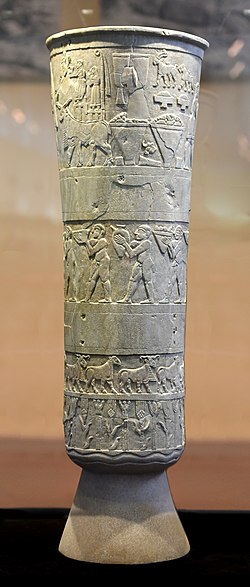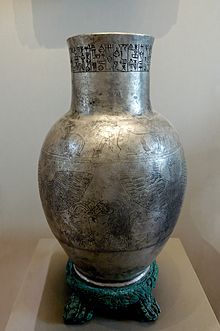Cylinders
Notes: Game on...on the radio...Angels and Blue Jays...top of sixth...Angels 9--1...messing with the Inca goblets, I noted they are lookalike with the modius,in particular the wide slender wider shape of the Wrik/Uruk vase...brb...oh, Lastella up...top of the Angels' order...fly out...two down...Trout up...Troutahere!...lol...missed the early part of the game, and offensive show...homerun...but still get to hear some more...Ohtani up...Angels 10-1....Trout just a triple away from the cycle...Ohtani base hit...wait...double...Ohtani fast on the bases...Upton back, and up...Angels make out...to bottom of sixth...
quote

https://en.wikipedia.org/wiki/Warka_Vase
unquote
quote
https://www.jstor.org/stable/594730?seq=1#page_scan_tab_contents
unquote
Vlady junior hits into DP...to top of seventh...Fletcher up...W...is 'qa' a modius?...Angels 123...to bottom of seventh...found that Entemena vase mentioned...it has a round oval body, but, the top narrow to a cylinder, much like a modius...thought here is the modius were like a specific shape and size for measuring grain...grain that was tribute/tax...
quote

https://en.wikipedia.org/wiki/Vase_of_Entemena
unquote
Jays wap a two run home run...Angels 10-3...and then a base hit...Jays make out...
quote
Whereas there are hundreds of samples of mina, only one sample of qa is known. and this is a sample of Euboic qa. The silver vase dedicated by the Sumerian ruler Entemena contains, by the appraisal of Léon Heuzey, 4.07 liters to the neck and 415 filled through the neck; Thureau-Dangin understood that the capacity is a saton of 10 Euboic qa, but could not decide whether one should reckon by the first or the second figure.
https://www.metrum.org/measures/volumeweight_u.htm
unit of measure was serious stuff to the ancients, as it is today...here, two ways to measure: "to the top", or "to the neck"...the vase has like two registers...the Uruk vase is banded, and has the illustrated registers...a guess: it was filled to the top band, the lower part being a cylinder before the flaring top, sorta!, and so consistent...it's too big to be used...and it is likely a stylized version of baskets of uniform size...hadn't thought, but sometimes registers could have been used like marks on a ruler, or on the sides of a measuring pitcher!...hmmph...what is 'mina'...Lastella ground out...Trout up...hit...Ohtani up...Ohtani with hit?, fc...Upton up...fly out...Angels make out...to top of eighth...bloop lead off hit...and, another two run home run...Angels 10-5...runner on on error...Valdy up...K...
Mina
https://en.wikipedia.org/wiki/Mina_(unit)#Images
Mina has more to do with coins...
quote
The external shape and materials were approximately the same: a ceramic jar about as high as a man, a base for standing, sides nearly straight or generously curved, large mouth with a lid, sealed for shipping. Jars of this size could not be handled by individuals, especially when full. Various numbers of handles, or lugs, or some combination, gave a purchase for some sort of harness used in lifting the jar with a crane.

Pithos from Iron-Age Crete. About 1.6 m tall, the full pithos would have weighed close to 2 tons.
Below: Pithoi at Knossos. Placed out of the pits for viewing, the pithoi stood in the pits for access and stability.
Below: Pithoi at Knossos. Placed out of the pits for viewing, the pithoi stood in the pits for access and stability.
https://en.wikipedia.org/wiki/Pithos
unquote
now and then, it comes over me how big and industrial ancient civilizations were--urban angst nothing new!...Jays made out...to top of ninth...Calhoun up...lead off W...so, the thought appears where ever one sees standard shapes in vases, they are measuring units...atop the Toltec Warrirors are cylinder headdresses, banded with what looks like stylized polygonal corn kernals...Calhoun hung up on hit to outfield by Fketcher that looked to be caught, but dropped...Fletch on first, fc rather than a hit...Bour up...ground out...Lucroy up...but that's a long reach of the moment!...
quote

Bronze modius measure (4th century AD) with inscription acknowledging Imperial regulation of weights and measures
https://www.revolvy.com/page/Ancient-Roman-units-of-measurement
unquote
quote
The Sāʿ (Arabic: صاع) is an ancient measurement of volume from the Islamic world, with cultural and religious significance. While its exact volume is uncertain, the Arabic word Sāʿ translates to "small container," related to the Quranic word ṣuwāʿ ("cup, goblet"). Together with the Mudd and the Makkūk, the Sāʿ is part of the system of units of volume used in the Arabic peninsula
https://en.wikipedia.org/wiki/Sa_(Islamic_measure)
unquote
unquote...hmmph...to easy to find!...fish in a barrel...
quote
Qirus were decorated by first cutting a shallow pattern on the surface of the cup, then filling the pattern with a durable, waterproof mixture of plant resin and pigment such as cinnabar.[3] The finely incised lines would meet at intersection points that collaborated to create shapes such as triangles, squares, and diamonds. The shapes are organized in two to four horizontal registers.

During Inca times, the vessels were typically made in identical pairs. This followed the custom that two individuals were required to drink together and both qirus in the pair would have identical size, shape, and decoration. These pairs were typically used for toasts in ceremonies and were also given along with textiles as gifts as a sign of Inca generosity.[
https://en.wikipedia.org/wiki/Qiru
unquote
it's been hard to search up the Qiru...it has many different spellings...and few wood ones have survived...initially, they had geometric designs, mostly, sorta, then after the conquest they have figures, or some such...Spanish became suspicious of them for witchcraft, and tried to ban them, without much luck...Angels make out...to bottom of ninth...
quote
The Inka people made the Jaguar goblet. The Inka people lived in Peru. They lived from 1470 to 1532. The goblets were made of a q'iru tree. The Inka people put circles, lines, or anything to make them look nice. They always made two of the goblets.
https://americanindian.si.edu/exhibitions/all_roads_are_good/MJaguar.htm
from school lesson...
quote

The most ancient keros are decorated with carved geometrical patterns filled with a resinous paint in lively shades of red and yellow. Inca keros have engraved geometrical patterns or bear the shape of a human or jaguar head.
https://icom.museum/en/object/inca-kero-wood-35-x-16-cm-museo-regional-de-cusco-peru/
unquote
quote
To consolidate the relationship between local communities and the Inca state, toasts were exchanged during ceremonial occasions and pairs of keros, often together with fine textiles, were given to provincial leaders as a sign of Inca generosity.
https://www.metmuseum.org/art/collection/search/316839
unquote
and then...lol...Angels win...Angels 10-5...put a halo over this one!
:)
DavidDavid










No comments:
Post a Comment